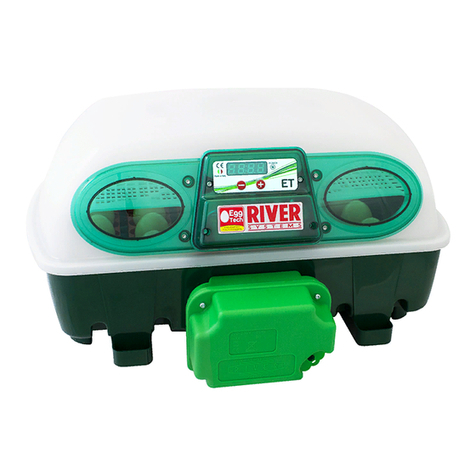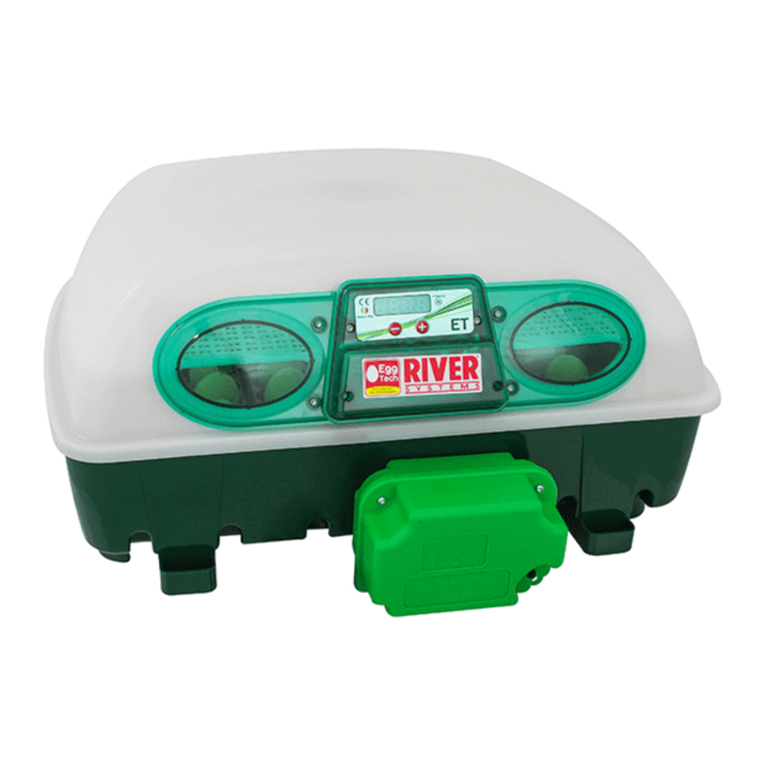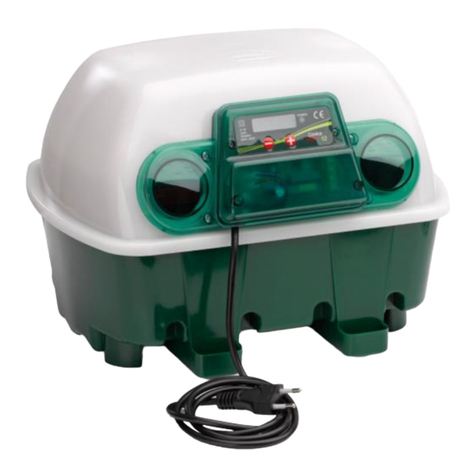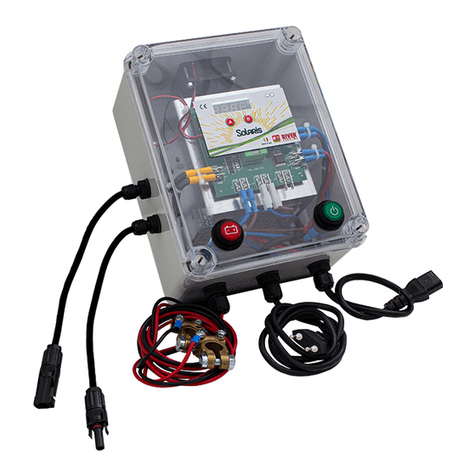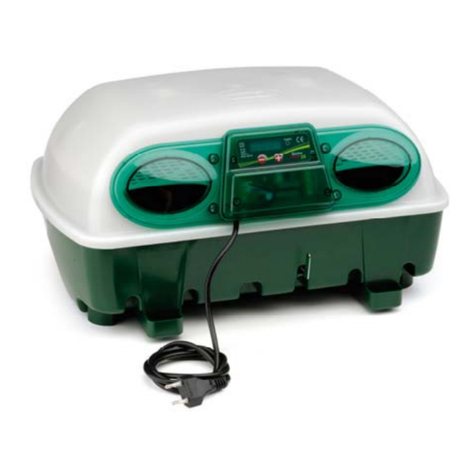river systems ET 12 User manual

IT
ENUser Manual
ITManuale di utilizzo
EggTech
1
0
0
%
M
A
D
E
I
N
I
T
A
L
Y
C
E
R
T
I
F
I
C
A
T
E
I
T
P
I
riversystems.it
riversystems.it
riversystems.it
riversystems.it
riversystems.it
riversystems.it
riversystems.it
riversystems.it
riversystems.it
riversystems.it
riversystems.it
riversystems.it
riversystems.it
riversystems.it
riversystems.it
riversystems.it
riversystems.it
riversystems.it
riversystems.it
riversystems.it
riversystems.it
riversystems.it
riversystems.it
riversystems.it
riversystems.it
riversystems.it
riversystems.it
riversystems.it
riversystems.it
riversystems.it

Copyright © 2020 River Systems - All rights reservedCopyright © 2020 River Systems - All rights reserved
IT
- 3 -
Grazie per aver acquistato questo prodotto River Systems®,
frutto di esperienze tecnologiche e di una costante ricerca!
In questo manuale troverete tutte le informazioni e i consigli per poter utilizzare l’incubatrice nel massimo della
sicurezza e dell’efcienza. Raccomandiamo di leggere attentamente il contenuto del manuale al ne
di poter intervenire correttamente nella manutenzione e poter sfruttare al meglio le caratteristiche speciche
dell’incubatrice.
Le descrizioni e le illustrazioni contenute nel presente manuale e nel pieghevole allegato non si intendono
vincolanti; le foto e le illustrazioni sono a scopo illustrativo e si riferiscono ai modelli ET 24 o ET 49.
River Systems srl pertanto si riserva il diritto di apportare modiche in qualunque momento e senza impegno,
di aggiornare la pubblicazione, di modicare componenti e accessori a scopo migliorativo, o per qualsiasi
esigenza di carattere costruttivo e/o commerciale in funzione di una maggiore sicurezza e funzionalità.
Le istruzioni, i disegni, le tabelle e tutto ciò che è contenuto nel presente manuale sono di natura tecnica e
riservata; per questo motivo nessuna informazione può essere comunicata a terzi senza l’autorizzazione scritta
di River Systems srl che ne è la proprietaria esclusiva.
In caso di contestazione il testo valido di riferimento rimane l’italiano. Foro competente di Padova.
DICHIARAZIONE DI CONFORMITÀ “CE”
Il sottoscritto Stefano Concina, in qualità di legale rappresentante della ditta River Systems®srl con sede in Via
Marco Polo, 33 (ZI), 35011 Campodarsego, Padova (Italia), partita IVA 04289370282 dichiara che l’incubatrice
come da etichetta riportata qui di seguito
è stata costruita rispettando le seguenti norme:
DIRETTIVE: LVD 2014/35/EU, EMC 2014/30/EU, ROHS 2011/65/EU
NORME: EN 60335-2-71:2003 + A1:2007, EN 60335-1:2012 + AC:2014 + A11:2014, EN 55014-1:2006 +
A1:2009 + A2:2011, EN 61000-3-2:2014, EN 61000-3-3:2013, EN 55014-2:2015, EN 62233:2008
ed è quindi conforme alle norme vigenti.
Qualsiasi modica apportata alla macchina senza il nostro consenso
rende la presente dichiarazione priva di ogni validità.
Campodarsego, 20.11.2020
Revisione manuale: 1.2
ATTENZIONE
LEGGERE ATTENTAMENTE IL MANUALE DI ISTRUZIONI
PRIMA DI ESEGUIRE QUALSIASI OPERAZIONE.
Informazioni aggiuntive sono state inserite nel pieghevole allegato. Nello specico si tratta delle foto esplicative
sull’uso dell’incubatrice, l’esploso dell’apparecchio e i suoi ricambi. Il pieghevole mostra inoltre esempi di uova,
come scegliere le uova da incubare e le foto delle varie fasi della speratura.
INCOLLARE QUI L’ETICHETTA
FORNITA ASSIEME
AL PRODOTTO
riversystems.it
riversystems.it
riversystems.it
riversystems.it
riversystems.it
riversystems.it
riversystems.it
riversystems.it
riversystems.it
riversystems.it
riversystems.it
riversystems.it
riversystems.it
riversystems.it
riversystems.it
riversystems.it
riversystems.it
riversystems.it
riversystems.it
riversystems.it
riversystems.it
riversystems.it
riversystems.it
riversystems.it
riversystems.it
riversystems.it
riversystems.it
riversystems.it
riversystems.it
riversystems.it
riversystems.it
riversystems.it
riversystems.it
riversystems.it
riversystems.it
riversystems.it
riversystems.it
riversystems.it
riversystems.it
riversystems.it
riversystems.it
riversystems.it
riversystems.it
riversystems.it
riversystems.it
riversystems.it
riversystems.it
riversystems.it
riversystems.it
riversystems.it
riversystems.it
riversystems.it
riversystems.it
riversystems.it
riversystems.it
riversystems.it
riversystems.it
riversystems.it
riversystems.it
riversystems.it
riversystems.it
riversystems.it

Copyright © 2020 River Systems - All rights reserved Copyright © 2020 River Systems - All rights reserved
- 4 - - 5 -
IT IT
INDICE
1. AVVERTENZE – PRECAUZIONI IMPORTANTI...........................................................................5
2. CARATTERISTICHE E DATI TECNICI DELL’INCUBATRICE........................................................6
2A. DESCRIZIONE DEL PRODOTTO.............................................................................................6
3. SELEZIONE E CONSERVAZIONE DELLE UOVA DA INCUBARE...............................................7
4. PREPARAZIONE E MESSA IN FUNZIONE DELL’INCUBATRICE................................................8
4A. COMANDI..............................................................................................................................8
4B. USO.....................................................................................................................................
4C. IMPOSTAZIONE E REGOLAZIONE DELLA TEMPERATURA..................................................9
4D. INFORMAZIONI PER UNA CORRETTA INCUBAZIONE - TUTTI GLI AVICOLI.........................9
4E. INCUBAZIONE DELLE UOVA DI ANATIDI ANSERIFORMI (OCA, ANATRA, ECC.)................10
4 F. INCUBAZIONE DELLE UOVA DI ALTRE SPECIE ESOTICHE................................................10
4G. TUTORIAL..........................................................................................................................11
4H. PROBLEMI TECNICI DURANTE L’USO DELLA MACCHINA................................................11
5. CONTROLLO PERIODICO DELLE UOVA DURANTE L’INCUBAZIONE (SPERATURA).............11
6. SCHIUSA E NASCITA DEL PULCINO......................................................................................12
7. PRIMI GIORNI DI VITA.............................................................................................................13
8. PROBLEMI CHE SI POSSONO VERIFICARE DURANTE L’INCUBAZIONE..............................13
9. PROBLEMI CHE SI POSSONO VERIFICARE IN SCHIUSA.....................................................15
10. MANUTENZIONE, PULIZIA E STOCCAGGIO A FINE CICLO...................................................15
11. RIMOZIONE DELL’UNITÀ GIRAUOVA.....................................................................................16
12. GARANZIA..............................................................................................................................16
13. SMALTIMENTO.......................................................................................................................17
14. TABELLA SOSTANZE DANNOSE PER LE PLASTICHE...........................................................33
PARTI INCUBATRICE (vedi pieghevole allegato)
1Pannello di controllo
1a Display digitale
1b LED di attivazione resistenza
1c Pulsante regolazione temperatura ( )
1d Pulsante regolazione temperatura ( )
2Scheda elettronica
3Oblò d’ispezione
4Cavo incubatrice
5Coperchio
6Tappo su foro per raccordo sistema di
umidicazione Nebula®
7Resistenza
8Supporti resistenza
9Distanziale
10 Turbina
11 Motore
12 Sonda di temperatura
13 Staffa supporto motore
14 Griglia protettiva
15 Coperchio completo
16 Asta vassoio portauova
17 Elemento vassoio portauova
18 Vassoio portauova completo
19 Griglia per la schiusa
20 Base incubatrice
21 Bocchetta di riempimento vaschetta acqua
22 Unità girauova “Ovomatic”
23 Chiavetta girauova
(per modello semiautomatico)
RICAMBI (vedi pieghevole allegato)
2
12 Scheda elettronica con sonda
6Tappo su foro per raccordo sistema di
umidicazione Nebula®
7Resistenza
10
11
13 Motore con turbina e staffe
15 Coperchio completo
16 Asta vassoio portauova
17 Elemento vassoio portauova
18 Vassoio portauova completo
19 Griglia per la schiusa
20 Base incubatrice
22 Unità girauova “Ovomatic”
23 Chiavetta girauova
(per modello semiautomatico)
1. AVVERTENZE - PRECAUZIONI IMPORTANTI
Quando si usano apparecchi elettrodomestici occorre sempre seguire alcune basilari precauzioni di sicurezza,
incluse le seguenti:
1. Utilizzare l’apparecchio solo se l’impianto elettrico presenta caratteristiche conformi a quanto riportato
sull’etichetta apposta sull’apparecchio stesso e nel presente manuale.
2. Durante l’uso, l’incubatrice deve essere posizionata su di un tavolo, ad un’altezza di almeno 500
mm dal pavimento, in posizione orizzontale, stabile e fissa.
3. Non porre l’incubatrice in prossimità di fonti di calore.
4. Tenere l’apparecchio al di fuori della portata dei bambini.
5. Questo apparecchio non è destinato all’uso da parte di persone (bambini compresi) con ridotte
capacità siche, mentali o sensoriali, o prive di esperienza e conoscenza, o non istruiti in merito all’uso
dell’apparecchio da parte di una persona responsabile della loro sicurezza.
6. Per evitare scosse elettriche, non immergere il coperchio in acqua o altri liquidi, stessa cosa vale per la
base nella versione con unità girauova art. 556M-1.
7. Non usare o riporre l’apparecchio in ambienti con sostanze corrosive, inammabili o esplosive.
8. Prima dell’utilizzo, e comunque prima di inserire la spina nella presa di corrente, vericare lo stato dei cavi
esterni. Per scollegare l’apparecchio staccare la spina dalla presa di corrente.
9. Non usare l’apparecchio se il cavo elettrico, la spina, il circuito elettronico o la griglia di protezione sono
danneggiati, oppure se l’incubatrice è caduta o in qualche modo danneggiata. Afdare l’apparecchio al
centro di assistenza autorizzato più vicino richiedendone la verica o la riparazione.
10. Se sul display compare la scritta ErtH o ErP1, scollegare l’incubatrice e rivolgersi al centro di assistenza.
11. Tenere l’incubatrice al riparo da urti.
12. Non aprire il frontalino di protezione della scheda elettronica o rimuovere la griglia di protezione della ventola.
L’ACCESSO ALLE PARTI CHIUSE O PROTETTE DELL’INCUBATRICE DEVE ESSERE EFFETTUATO
ESCLUSIVAMENTE DA PERSONALE AUTORIZZATO E SPECIALIZZATO SOLTANTO PER OPERAZIONI
DI MANUTENZIONE.
13. Staccare la spina dalla presa di corrente quando non si utilizza l’apparecchio, prima di procedere all’apertura
(sollevamento del coperchio) e alla pulizia.
14. Pulire la macchina solo dopo la ne del processo di incubazione.
15. Non utilizzare accessori non originali: accessori non raccomandati o non venduti dalla ditta produttrice
possono causare incidenti.
16. Non utilizzare all’aperto.
17. Non lasciare il cavo sospeso sul bordo del tavolo e assicurarsi che non costituisca intralcio al libero
passaggio. Il cavo deve essere protetto e reso inaccessibile agli animali.
18. È preferibile che la formazione degli utilizzatori della macchina sia documentata.
19. CONSERVARE CON CURA QUESTE ISTRUZIONI.
20. Le informazioni in materia di incubazione presenti in questo manuale provengono dall’esperienza pluriennale
dei nostri collaboratori e sono confermate da zoologi affermati. Ciò non implica, tuttavia, che siano infallibili,
data la grande e complessa variabilità dei fenomeni biologici. La macchina è pre-settata per offrire le
condizioni di incubazione standard all’utilizzatore principiante; l’utente esperto può modicare i parametri
a seconda delle esigenze e delle esperienze personali.
ATTENZIONE!
IN CASO DI ARRESTO DELLA VENTOLA DURANTE IL PERIODO DI INCUBAZIONE STACCARE
IMMEDIATAMENTE LA SPINA E RIVOLGERSI AL CENTRO DI ASSISTENZA!
NOTA:
LA DITTA PRODUTTRICE NON PUO’ ESSERE RITENUTA IN ALCUN CASO RESPONSABILE DI
INCIDENTI O DANNI CONSEGUENTI AD USI NON PREVISTI DELL’APPARECCHIO. QUALSIASI
USO NON PREVISTO DELL’APPARECCHIO COMPORTA INOLTRE IL DECADIMENTO DEI TERMINI
DI GARANZIA.
PERICOLO!
L’ACCESSO ALLE PARTI CHIUSE O PROTETTE DELL’INCUBATRICE DEVE ESSERE EFFETTUATO
ESCLUSIVAMENTE DA PERSONALE AUTORIZZATO E SPECIALIZZATO SOLTANTO PER
OPERAZIONI DI MANUTENZIONE.
ATTENZIONE:
POICHE’ SAREBBE IMPOSSIBILE DESCRIVERE TUTTE LE OPERAZIONI CHE NON
DEVONO O NON POSSONO ESSERE ESEGUITE, TUTTE LE OPERAZIONI (DIVERSE DALLE
NORMALI LAVORAZIONI) CHE NON SONO ESPLICITAMENTE DESCRITTE NEL MANUALE
DELL’INCUBATRICE, SONO DA CONSIDERARSI NON FATTIBILI.
QUESTO SEGNALE INDICA LA PRESENZA DI PARTI SOTTO TENSIONE.
8
riversystems.it
riversystems.it
riversystems.it
riversystems.it
riversystems.it
riversystems.it
riversystems.it
riversystems.it
riversystems.it
riversystems.it
riversystems.it
riversystems.it
riversystems.it
riversystems.it
riversystems.it
riversystems.it
riversystems.it
riversystems.it
riversystems.it
riversystems.it
riversystems.it
riversystems.it
riversystems.it
riversystems.it
riversystems.it
riversystems.it
riversystems.it
riversystems.it
riversystems.it
riversystems.it
riversystems.it
riversystems.it
riversystems.it
riversystems.it
riversystems.it
riversystems.it
riversystems.it
riversystems.it
riversystems.it
riversystems.it
riversystems.it
riversystems.it
riversystems.it
riversystems.it
riversystems.it
riversystems.it
riversystems.it
riversystems.it
riversystems.it
riversystems.it
riversystems.it
riversystems.it
riversystems.it
riversystems.it
riversystems.it
riversystems.it
riversystems.it
riversystems.it
riversystems.it
riversystems.it
riversystems.it
riversystems.it

Copyright © 2020 River Systems - All rights reserved Copyright © 2020 River Systems - All rights reserved
- 6 - - 7 -
IT IT
2.
CARATTERISTICHE E DATI TECNICI DELL’INCUBATRICE
ET 12 ET 24 ET 49
Tensione 230 Volt 50/60 Hz monofase
Potenza massima 80 Watt 130 Watt 170 Watt
Consumo medio giornaliero Max.
1,0 kW/24 ore Max.
1,7 kW/24 ore Max.
2,3 kW/24 ore
Dimensioni (PxLxA)
Incubatrice semiautomatica 280x360x260 mm 340x500x255 mm 520x580x250 mm
Incubatrice con unità girauova 320x360x260 mm 380x500x255 mm 570x580x250 mm
Peso
Incubatrice semiautomatica 2,57 kg 3,47 kg 5,46 kg
Incubatrice con unità girauova 3,08 kg 3,98 kg 5,97 kg
Capacità incubatrice
(Il numero di uova alloggiabili nel
vassoio ad alveoli varia in base alla
grandezza delle uova stesse)
Uova di medie/grandi dimensioni circa 12 circa 24 circa 49
Uova di piccole dimensioni (es.
quaglia) circa 48 circa 96 circa 196
Range della temperatura Da 30°C a 40°C
Grado di protezione incubatrice
completa IPX4
Tipo di uova da incubare
Gallina, fagiano, faraona, quaglia, starna, pernice, tacchino, pal-
mipedi (oca, anatra comune, anatra selvatica, anatra muta, anatra
germanata, ecc.), pavone, coturnice, piccione, colino, uccelli esotici
e rapaci
Corpo Materiale plastico
Cablaggio esterno Cavi di alimentazione a due poli in doppio isolamento
Display Controllo digitale della temperatura con punto decimale
Ventilazione A turbina
Sonda di temperatura Elettronica di precisione +/-0,1°C
Umidità nell’incubatrice 40-50% con acqua in una vaschetta
55-65% con acqua in entrambe le vaschette
Numero di inclinazioni nelle 24
ore (con uova poste nel vassoio
portauova ad alveoli)
Incubatrice
semiautomatica:
minimo 4 volte
Incubatrice con
unità girauova:
un’inclinazione ogni due ore
2A - DESCRIZIONE DEL PRODOTTO
L’incubatrice ET River Systems® è progettata per far nascere pulcini di gallina, fagiano, faraona, quaglia,
starna, pernice, palmipedi (anatra muta/comune/selvatica, oca ecc.), pavone, tacchino, coturnice, piccione,
colino, uccelli esotici e rapaci.
Il calore necessario per l’incubazione viene generato da una resistenza elettrica comandata da un controllo
digitale a microcomputer PID di ultima generazione, che permette di regolare la temperatura media interna
attraverso i tasti posti sul display, in maniera costante e precisa.
La ventilazione avviene per mezzo di una ventola a turbina che distribuisce in maniera uniforme l’aria calda e
umida. Grazie all’acqua contenuta nelle vaschette presenti sul fondo dell’incubatrice si verica l’umidicazione
naturale a supercie. Il riempimento delle vaschette avviene attraverso le due bocchette poste all’esterno,
senza bisogno di aprire la macchina.
INCUBATRICE SEMIAUTOMATICA INCUBATRICE CON UNITÀ GIRAUOVA
OVOMATIC
È dotata di un sistema semiautomatico per
l’inclinazione delle uova, azionabile dall’esterno
grazie a una levetta collegata al dispositivo ad
alveoli collocato nella base dell’incubatrice.
È fornita di un sistema automatico per l’inclinazione
delle uova che compie un ciclo completo ogni 4
ore, azionabile dall’esterno grazie a un motore.
3.
SELEZIONE E CONSERVAZIONE DELLE UOVA DA INCUBARE
• È importante sapere che le uova che hanno viaggiato possono avere una percentuale di schiusa inferiore
al 50%, a seguito di diversi fattori:
- Stress di viaggio;
- Vibrazioni;
- Escursioni termiche;
- Asssia degli embrioni causata da imballi occlusivi.
• Nel caso in cui sia necessario utilizzare uova che abbiano viaggiato, prima di incubarle occorre lasciarle
riposare per almeno 24 ore con la punta rivolta verso il basso in un vassoio portauova.
• Scegliere uova provenienti da riproduttori che siano ben sviluppati, ben nutriti e sani, poiché alcune malattie
dei avicoli domestici e selvatici si trasmettono dalla femmina alle uova e possono causare la morte del
pulcino nell’uovo.
• I riproduttori non devono essere consanguinei: i maschi devono arrivare da un altro allevamento, altrimenti
daranno origine a uova con embrioni deboli destinati a morire in fase di schiusa o che, se riusciranno a
venire alla luce, saranno animali vulnerabili e di salute cagionevole.
• Per avere una maggiore percentuale di uova fertili prestare attenzione all’età ideale dei riproduttori, tenendo
a mente che l’età ideale varia in base alla specie (ad esempio, deve essere dai 2 ai 4 anni per le galline,
mentre i galli devono essere cambiati ogni anno). Si devono inoltre rispettare le giuste proporzioni tra
maschi e femmine e creare un ambiente idoneo agli animali nel rispetto del loro benessere.
• L’embrione inizia il suo sviluppo prima della deposizione dell’uovo da parte della gallina; un uovo fecondato,
appena deposto, può essere paragonato a un bambino di 5 giorni. Dopo la deposizione lo sviluppo
embrionale si blocca e può riprendere, in caso di incubazione articiale, dopo 7 giorni.
Le regole sottostanti aiuteranno ad ottenere uova idonee per l’incubazione:
1. Raccogliere frequentemente le uova, possibilmente la mattina presto ed entro mezzogiorno, al ne di
evitare che siano esposte a luce diretta, raggi ultravioletti e alte temperature.
2. Non conservare mai le uova in frigorifero.
3. Non incubare uova sporche: la contaminazione porta alla morte del pulcino.
4. Lavare le uova delicatamente e con acqua tiepida, per evitare l’escursione termica. È possibile utilizzare
un apposito disinfettante che provochi la distruzione sica di microrganismi patogeni di origine fungina,
batterica e virale. Evitare di spazzolarle, per non incidere la membrana esterna e favorire così l’ingresso di
batteri.
5. Conservare le uova in un locale fresco con una temperatura tra +15°C e +18°C e un’umidità di circa
65-75%. In caso le uova siano state, per brevi periodi, sottoposte a temperature diverse da quelle sopra
indicate, fare comunque attenzione che non abbiano subito temperature al di sotto dei +5°C o sopra i
+24°C.
6. È essenziale conservare le uova nel vassoio con la punta rivolta verso il basso.
7. Le uova sono adatte all’incubazione dal secondo al sesto/settimo giorno dalla deposizione. Incubare uova
più vecchie di 8 giorni abbassa di molto la percentuale di nascite.
8. Le uova scelte per l’incubazione non devono essere raccolte nei periodi in cui gli animali sono sottoposti a
stress causato da alte o basse temperature.
9. Scegliere uova di forma normale: non devono essere allungate, sferiche, ondulate o con qualsiasi altra
malformazione.
10. Il guscio dell’uovo non deve essere crepato, rotto, rugoso, molle, sottile o con punti bluastri (uova vecchie).
11. Consigliamo di munirsi di sperauova per esaminare le eventuali uova incrinate, non visibili a occhio nudo.
12. Permettere alle uova fredde (dalla temperatura di conservazione) di raggiungere lentamente la temperatura
della stanza prima di metterle nell’incubatrice. Il passaggio brusco da +14°C a +38°C può provocare la
condensa sul guscio, tra le cause di riduzione delle nascite.
13. Uova di specie diverse necessitano di parametri diversi. Incubarle assieme è possibile, ma è un processo
delicato.
14. Durante l’incubazione, non inserire le uova in tempi diversi.
SUGGERIMENTI: se si acquistano le uova presso allevamenti amatoriali, vericare che questi siano
registrati e in linea con le vigenti normative in materia di benessere animale. Disporre di buon materiale
genetico consente di ottenere animali di pezzatura e produttività migliori, oltre a ridurre il rischio di
incubare uova con alte cariche batteriche o malattie, con conseguenti scarsi risultati di schiusa.
IMPORTANTE: è fondamentale tenere conto del mese in cui si effettua l’incubazione, poiché le medie di fertilità
fuori stagione sono regolarmente molto basse. In ogni caso, tenere a mente che la fertilità è specialmente genetica.
Consultare il graco G1 di seguito riportato per osservare la fertilità media
embrionale in base alla lunghezza mensile del fotoperiodo dell’emisfero boreale.
riversystems.it
riversystems.it
riversystems.it
riversystems.it
riversystems.it
riversystems.it
riversystems.it
riversystems.it
riversystems.it
riversystems.it
riversystems.it
riversystems.it
riversystems.it
riversystems.it
riversystems.it
riversystems.it
riversystems.it
riversystems.it
riversystems.it
riversystems.it
riversystems.it
riversystems.it
riversystems.it
riversystems.it
riversystems.it
riversystems.it
riversystems.it
riversystems.it
riversystems.it
riversystems.it
riversystems.it
riversystems.it
riversystems.it
riversystems.it
riversystems.it
riversystems.it
riversystems.it
riversystems.it
riversystems.it
riversystems.it
riversystems.it
riversystems.it
riversystems.it
riversystems.it
riversystems.it
riversystems.it
riversystems.it
riversystems.it
riversystems.it
riversystems.it
riversystems.it
riversystems.it
riversystems.it
riversystems.it
riversystems.it
riversystems.it
riversystems.it
riversystems.it
riversystems.it
riversystems.it
riversystems.it
riversystems.it

Copyright © 2020 River Systems - All rights reserved Copyright © 2020 River Systems - All rights reserved
- 8 - - 9 -
IT IT
G1
4. PREPARAZIONE E MESSA IN FUNZIONE DELL’INCUBATRICE
Il locale in cui si colloca l’incubatrice deve essere in penombra, avere una temperatura compresa tra +20°C
e +25°C (temperature troppo alte, sopra i 28°C possono provocare morti embrionali), umidità compresa tra il
40-50% (l’umidità esterna condiziona l’umidità interna della macchina), essere privo di correnti d’aria, pulito,
ben aerato e confortevole. Assicurarsi che la macchina non venga esposta ai raggi diretti del sole o collocata
vicino a fonti di calore come termosifoni, stufe, ecc. Si consiglia pertanto di tenerla in casa.
Non usare o conservare l’incubatrice in locali dove siano presenti sostanze chimiche, velenose, tossiche o
inammabili (anche in piccole concentrazioni), poiché hanno un’inuenza negativa sullo sviluppo degli embrioni.
Non utilizzare l’incubatrice dove ci sia il pericolo di spruzzi d’acqua o altre sostanze.
4A - COMANDI
Il dispositivo non dispone di interruttore ON/OFF. L’inserimento della spina nella presa di corrente attiva la
resistenza elettrica e i motori.
4B - USO
Il funzionamento è molto semplice:
a) Sanicare la macchina prima di iniziare il processo di incubazione (vedi punto 10). Le condizioni ambientali
che si realizzano all’interno dell’incubatrice durante il processo di incubazione sono l’ideale per lo sviluppo
e la proliferazione di batteri dannosi tra i quali Salmonella, Campylobacter, Staphylococcus, Legionella,
Escherichia coli, ecc.
b) Posizionare l’incubatrice sopra un tavolo piano alto minimo 50 cm dal pavimento, in posizione
orizzontale, stabile e fissa. Il fondo deve appoggiare direttamente sul piano del tavolo per evitare che
qualsiasi oggetto (una coperta, una tovaglia, ecc.) possa ostruire i fori di aerazione.
c) Togliere il coperchio e appoggiarlo a anco dell’incubatrice con la griglia rivolta verso il basso.
d) Togliere la griglia di schiusa dalla base dell’incubatrice: essa è necessaria solo per la schiusa (ultimi 3
giorni). MAI LASCIARLA NELL’INCUBATRICE DURANTE IL PERIODO DI INCUBAZIONE! (foto A).
NB: lasciare la griglia di schiusa appoggiata in un luogo piano al ne di evitare che si deformi (foto B).
e) - Incubatrice semiautomatica: controllare che il vassoio portauova ad alveoli sia posizionato correttamente
nelle sue sedi e che le le di alveoli si inclinino liberamente nei due sensi (foto C).
- Incubatrice con unità girauova OVOMATIC: controllare che la levetta in metallo posta nella parte anteriore
dell’incubatrice entri perfettamente nella fessura posizionata sul vassoio portauova, che deve a quel punto
rimanere saldo e immobile, e che le le di alveoli alloggino correttamente nelle rispettive sedi (foto D).
f) Riempire di acqua tiepida, preferibilmente demineralizzata, la vaschetta di sinistra. Utilizzare la bocchetta
corrispondente posta sul piedino della macchina (foto E). Versare l’acqua lentamente e fare attenzione
a non farla tracimare dalla vaschetta: un eccesso di liquido causa un aumento del tasso di umidità che
porta alla diminuzione delle nascite. La seconda vaschetta (di destra) verrà riempita solo nella fase nale di
schiusa. L’acqua può essere rabboccata anche quando l’apparecchio è in funzione.
g) Riposizionare il coperchio assicurandosi che il bordo della parte inferiore si incastri perfettamente nella
canalina alla base del coperchio (foto F).
h) Inserire la spina collegata al coperchio in una presa di corrente appropriata. La turbina si accende
immediatamente, seguita dal display che mostra la temperatura interna dell’incubatrice. Il LED indica
che la resistenza è in funzione (foto G). Esso resterà acceso no al raggiungimento della temperatura
impostata, dopodiché inizierà a lampeggiare.
i) La macchina è preimpostata ad una temperatura di 37,7°C, ideale per la maggior parte delle specie di
volatili. È comunque preferibile reimpostare la temperatura come descritto al punto 4C.
j) Dopo aver impostato la temperatura, lasciare la macchina in funzione vuota (senza uova) per almeno
2-3 ore per far stabilizzare temperatura e umidità quando la si avvia.Dopo essersi accertati che
la macchina funzioni correttamente (vedi punto 4C), staccare la spina e togliere il coperchio, posandolo
accanto all’incubatrice. Mettere delicatamente le uova negli alveoli con la punta rivolta verso il basso.
Richiudere l’incubatrice e ricollegare la spina. L’incubatrice deve essere riempita almeno per l’80% della
sua capacità.
k) Non coprire mai l’incubatrice né tenerla dentro ad una scatola mentre è in funzione. Ciò impedirebbe il
ricambio di aria al suo interno, necessario per lo sviluppo dell’embrione, che avviene attraverso i fori di
aerazione presenti sia nella base dell’incubatrice che dai due oblò di ispezione.
l) A questo punto inizia il ciclo di incubazione. Si consiglia di segnare il giorno su un calendario e di seguire
le istruzioni riportate nella tabella presente nella sezione 4D “Informazioni per una corretta incubazione”.
Controllare giornalmente la presenza dell’acqua nella vaschetta, vericandone il livello attraverso la
bocchetta (il livello che si vede dentro alla bocchetta di riempimento corrisponde a quello nella vaschetta).
Quando necessario, rabboccare con acqua preferibilmente demineralizzata, pulita e tiepida (+35/40°C).
m) Tenere presente che è lo specchio d’acqua (cioè la supercie) e non la quantità a generare l’umidità,
pertanto l’altezza dell’acqua nella vaschetta non inuirà sul tasso di umidità. La verica puntuale e costante
della presenza di acqua nella vaschetta aiuterà a garantire l’umidità necessaria, evitando che l’ambiente
dentro l’incubatrice resti asciutto. In caso di interruzione di corrente, appoggiare sui 4 lati dell’incubatrice
altrettante bottiglie contenenti acqua calda e mettere una coperta sopra il tutto. Questo permette di
mantenere una certa temperatura all’interno dell’incubatrice. Togliere il tutto non appena torna la corrente.
n) Sostituire la posizione delle uova ogni 5 giorni, scambiando quelle al centro con quelle ai lati, garantisce
una migliore omogeneità di schiusa.
ATTENZIONE:
• SE LA VENTOLA NON SI METTE IN FUNZIONE, STACCARE IMMEDIATAMENTE LA SPINA E
RIVOLGERSI AL CENTRO DI ASSISTENZA.
• SE DURANTE IL FUNZIONAMENTO SUL DISPLAY COMPAIONO LE SCRITTE ErtH O ErP1,
SCOLLEGARE L’INCUBATRICE E RIVOLGERSI AL CENTRO ASSISTENZA.
4C - IMPOSTAZIONE E REGOLAZIONE DELLA TEMPERATURA
Per impostare e modicare la temperatura premere i tasti ( ) oppure il tasto ( ) posti sul pannello di controllo.
Premendo uno dei due tasti si entra in modalità programmazione (sul display appare la lettera “P” accanto ai
gradi – foto H). Premere ad impulsi il tasto ( ) oppure il tasto ( ) per impostare la temperatura desiderata.
Attendere qualche istante che venga memorizzata (ricompare la temperatura interna del momento e la lettera
“C” – foto I).
Una volta impostata la nuova temperatura, attendere che la macchina si stabilizzi per vericare che essa venga
raggiunta. Se la temperatura viene aumentata la resistenza si attiverà (il LED sarà acceso) riscaldando l’aria
no al suo raggiungimento. Se la temperatura viene abbassata la resistenza resterà inattiva (il LED sarà spento)
per permettere all’aria all’interno dell’incubatrice di raffreddarsi.
La temperatura visualizzata sul display è una media di 12 punti rilevati all’interno dell’incubatrice tramite l’utilizzo
di termometri professionali tarati annualmente, certicata da un laboratorio accreditato. È quindi sconsigliato
introdurre termometri non idonei per la verica delle temperature.
4D - INFORMAZIONI PER UNA CORRETTA INCUBAZIONE - TUTTI GLI AVICOLI
Per ottenere un’incubata di successo fare riferimento alla seguente tabella. Attenzione: il tempo di incubazione
è indicativo. Si consiglia di lasciare accesa l’incubatrice 2/3 giorni in più rispetto a quelli indicati, al ne di dar
modo ai ritardatari (che non sono stati quindi eliminati durante la speratura - vedi punto 5) di nascere.
INCUBATRICE SEMIAUTOMATICA INCUBATRICE CON UNITÀ GIRAUOVA
OVOMATICA
Minimo 4 volte al giorno cambiare l’inclinazione
delle uova alloggiate nel vassoio portauova ad
alveoli agendo sulla levetta posta nella parte
anteriore dell’incubatrice. Girare la levetta verso
destra o sinistra alternativamente, fermandola
nella posizione corrispondente alle ore 10 o
14 di un orologio (foto K). MAI LASCIARE LA
LEVETTA (E DI CONSEGUENZA LE UOVA) IN
POSIZIONE VERTICALE (ORE 12). Muovere la
levetta con delicatezza per evitare traumi alle
uova. Importante: il numero di ore in cui l’uovo è
stato in una posizione dev’essere replicato nella
posizione opposta.
Avviare l’unità girauova inserendo la spina di
alimentazione collegata al dispositivo in una
presa di corrente appropriata. L’unità girauova
inizierà a funzionare. Il vassoio portauova effettua
un’inclinazione ogni due ore (foto J).
Attenzione: il movimento non sarà evidente
in quanto molto lento. Assicurarsi comunque
che questo accada.
riversystems.it
riversystems.it
riversystems.it
riversystems.it
riversystems.it
riversystems.it
riversystems.it
riversystems.it
riversystems.it
riversystems.it
riversystems.it
riversystems.it
riversystems.it
riversystems.it
riversystems.it
riversystems.it
riversystems.it
riversystems.it
riversystems.it
riversystems.it
riversystems.it
riversystems.it
riversystems.it
riversystems.it
riversystems.it
riversystems.it
riversystems.it
riversystems.it
riversystems.it
riversystems.it
riversystems.it
riversystems.it
riversystems.it
riversystems.it
riversystems.it
riversystems.it
riversystems.it
riversystems.it
riversystems.it
riversystems.it
riversystems.it
riversystems.it
riversystems.it
riversystems.it
riversystems.it
riversystems.it
riversystems.it
riversystems.it
riversystems.it
riversystems.it
riversystems.it
riversystems.it
riversystems.it
riversystems.it
riversystems.it
riversystems.it
riversystems.it
riversystems.it
riversystems.it
riversystems.it
riversystems.it
riversystems.it
Other manuals for ET 12
2
This manual suits for next models
5
Table of contents
Languages:
Other river systems Accessories manuals
